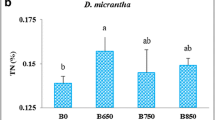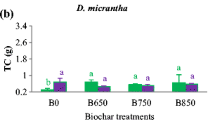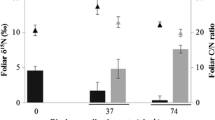Abstract
Purpose
Re-establishment of soil nitrogen (N) capital is a priority in mine rehabilitation. We aimed to evaluate the effects of biochar addition on improving mine spoil N pools and the influence of elevated CO2 concentration on mine rehabilitation.
Materials and methods
We assessed the effects of pinewood biochar, produced at three temperatures (650, 750 and 850 °C, referred as B650, B750 and B850, respectively), on mine spoil total N concentrations with five different plant species, including a tree species (Eucalyptus crebra), N-fixing shrubs (Acacia floribunda and Allocasuarina littoralis) and C3 and C4 grasses (Austrodanthonia tenuior and Themeda australis) incubated at ambient (400 μL L−1) and elevated (700 μL L−1) atmospheric CO2 concentrations, as well as the effects of elevated CO2 on mine rehabilitation.
Results and discussion
Soil total N significantly improved following biochar incorporation under all plant species (P < 0.05) except for T. Australis. E. crebra had the highest soil total N (0.197%, 0.198% and 0.212% for B650, B750 and B850, respectively). Different from the negligible influence of elevated CO2 on soil properties under the grasses and the N-fixing shrubs, elevated CO2 significantly increased soil water and hot water extractable organic C (WEOC and HWEOC, respectively) and decreased total C under E. crebra, indicating that the nutrient demands were not met.
Conclusions
Biochar addition showed the potential in mine rehabilitation in terms of improving soil N pool, especially with E. crebra. However, it would be more difficulty to rehabilitate mine spoils in future with the rising atmospheric CO2 concentration.
Similar content being viewed by others
References
Agrawal R, Imielinski T, Swami A (1993) Database mining: a performance perspective. knowledge and data engineering. IEEE Trans Knowl Data Eng 5:914–925
Ainsworth EA, Long SP (2005) What have we learned from 15 years of free-air CO2 enrichment (FACE)? A meta-analytic review of the responses of photosynthesis, canopy properties and plant production to rising CO2. New Phytol 165:351–372
Anawar HM, Akter F, Solaiman ZM, Strezov V (2015) Biochar: an emerging panacea for remediation of soil contaminants from mining, industry and sewage wastes. Pedosphere 25:654–665
Anderson IC, Drigo B, Ghannoum O, Chambers SM, Tissue DT, Cairney JWG (2013) Interactive effects of preindustrial, current and future atmospheric CO2 concentrations and temperature on soil fungi associated with two Eucalyptus species. FEMS Microbiol Ecol 83:425–437
Azapagic A (2004) Developing a framework for sustainable development indicators for the mining and minerals industry. J Clean Prod 12:639–662
Bai SH, Blumfield TJ, Reverchon F (2014) The impact of mulch type on soil organic carbon and nitrogen pools in a sloping site. Biol Fertil Soils 50:37–44
Bai SH, Reverchon F, Xu CY et al (2015a) Wood biochar increases nitrogen retention in field settings mainly through abiotic processes. Soil Biol Biochem 90:232–240
Bai SH, Xu CY, Xu Z et al (2015b) Soil and foliar nutrient and nitrogen isotope composition (δ15N) at 5 years after poultry litter and green waste biochar amendment in a macadamia orchard. Environ Sci Pollut Res 22:3803–3809
Biederman LA, Harpole WS (2013) Biochar and its effects on plant productivity and nutrient cycling: a meta-analysis. GCB Bioenergy 5:202–214
Blagodatskaya E, Blagodatsky S, Dorodnikov M, Kuzyakov Y (2010) Elevated atmospheric CO2 increases microbial growth rates in soil: results of three CO2 enrichment experiments. Glob Chang Biol 16:836–848
Bradford MA, Davies CA, Frey SD et al (2008) Thermal adaptation of soil microbial respiration to elevated temperature. Ecol Lett 11:1316–1327
Bradshaw A (1997) Restoration of mined lands-using natural processes. Ecol Eng 8:255–269
Bradshaw A (2000) The use of natural processes in reclamation-advantages and difficulties. Landsc Urban Plan 51:89–100
Bruun EW, Ambus P, Egsgaard H, Hauggaard-Nielsen H (2012) Effects of slow and fast pyrolysis biochar on soil C and N turnover dynamics. Soil Biol Biochem 46:73–79
Cayuela M, Van Zwieten L, Singh B, Jeffery S, Roig A, Sánchez-Monedero M (2014) Biochar's role in mitigating soil nitrous oxide emissions: a review and meta-analysis. Agric Ecosyst Environ 191:5–16
Chen CR, Xu ZH (2005) Soil carbon and nitrogen pools and microbial properties in a 6-year-old slash pine plantation of subtropical Australia: impacts of harvest residue management. For Ecol Manag 206:237–247
Chen Y, Shinogi Y, Taira M (2010) Influence of biochar use on sugarcane growth, soil parameters, and groundwater quality. Soil Res 48:526–530
Cheng W (1999) Rhizosphere feedbacks in elevated CO2. Tree Physiol 19:313–320
Choi Y, Wang Y, Hsieh YP, Robinson L (2001) Vegetation succession and carbon sequestration in a coastal wetland in northwest Florida: evidence from carbon isotopes. Glob Biogeochem Cycles 15:311–319
Clarkson BR, Schipper LA, Moyersoen B, Silvester WB (2005) Foliar 15N natural abundance indicates phosphorus limitation of bog species. Oecologia 144:550–557
Clemmensen K, Bahr A, Ovaskainen O et al (2013) Roots and associated fungi drive long-term carbon sequestration in boreal forest. Science 339:1615–1618
Curlevski NJA, Drigo B, Cairney JWG, Anderson IC (2014) Influence of elevated atmospheric CO2 and water availability on soil fungal communities under Eucalyptus saligna. Soil Biol Biochem 70:263–271 #equal author contribution
Dalenberg J, Jager G (1989) Priming effect of some organic additions to 14C-labelled soil. Soil Biol Biochem 21:443–448
Dawson TE, Mambelli S, Plamboeck AH, Templer PH, Tu KP (2002) Stable isotopes in plant ecology. Annu Rev Ecol Syst 33:507–559
De Graaff MA, Van Groenigen KJ, Six J, Hungate B, Van Kessel C (2006) Interactions between plant growth and soil nutrient cycling under elevated CO2: a meta-analysis. Glob Chang Biol 12:2077–2091
Deenik JL, McClellan T, Uehara G, Antal MJ, Campbell S (2010) Charcoal volatile matter content influences plant growth and soil nitrogen transformations. Soil Sci Soc Am J 74:1259–1270
Deluca TH, Gundale MJ, Mackenzie MD, Jones DL (2015) Biochar effects on soil nutrient transformations. In: Lehmann J, Joseph S (eds) Biochar for environmental management: science. Technology and Implementation. Routledge Publishers, New York, pp 421–454
Dempster DN, Jones DL, Murphy DV (2012) Clay and biochar amendments decreased inorganic but not dissolved organic nitrogen leaching in soil. Soil Res 50:216–221
Downie A, Crosky A, Munroe P (2009) Physical properties of biochar. In: Lehmann J, Joseph S (eds) Biochar for environmental management: science, technology and implementation. Earthscan Publishers, London, pp 13–32
Dragovich D, Patterson J (1995) Condition of rehabilitated coal mines in the Hunter Valley, Australia. Land Degrad Dev 6:29–39
Drake JE, Gallet-Budynek A, Hofmockel KS et al (2011) Increases in the flux of carbon belowground stimulate nitrogen uptake and sustain the long-term enhancement of forest productivity under elevated CO2. Ecol Lett 14:349–357
Drigo B, Kowalchuk GA (2013) Rhizosphere responses to elevated CO2. In: de Bruijn FJ (ed) Molecular microbial ecology of the rhizosphere. Wiley-Blackwell Publishers, New Jersey, pp 1063–1074
Drigo B, Kowalchuk GA, Yergeau E, Bezemer TM, Boschker HTS, van Veen JA (2007) Impact of elevated CO2 on the rhizosphere communities of Carex arenaria and Festuca rubra. Glob Chang Biol 13:2396–2410
Drigo B, Kowalchuk GA, van Veen JA (2008) Climate change goes underground: effects of elevated atmospheric CO2 on microbial community structure and activities in the rhizosphere. Rev Biol Fertil Soils 44:667–679
Drigo B, van Veen JA, Kowalchuk GA (2009) Specific rhizosphere bacterial and fungal groups respond differently to elevated atmospheric. ISME J 3:1204–1217
Drigo B, Veen JA, Pijl AS, Kielak AM, Gamper HA, Houtekamer MJ, Boschker HTS, Bodelier PLE, Whiteley AS, Kowalchuk GA (2010) Shifting carbon flow from roots into associated microbial communities in response to elevated atmospheric CO2. Proc Natl Acad Sci U S A 107:10938–10942
Drigo B, Kowalchuk GA, Knaap BM, Pijl AS, Boschker TS, Veen JA (2013) Impacts of three years of elevated atmospheric CO2 on rhizosphere carbon flow and microbial community dynamics. Glob Chang Biol 19:621–636
Dutta RK, Agrawal M (2000) Reclamation of mine spoils: a need for coal industry. In: Arvind K, Goel PK (eds) Industry, environment and pollution. Technoscience Publications, Jaipur, pp 239–250
Eusterhues K, Rumpel C, Kleber M, Kögel-Knabner I (2003) Stabilisation of soil organic matter by interactions with minerals as revealed by mineral dissolution and oxidative degradation. Org Geochem 34:1591–1600
Finzi AC, Moore DJP, DeLucia EH et al (2006) Progressive nitrogen limitation of progressive ecosystem processes under elevated CO2 in a warm-temperate forest. Ecology 87:15–25
Fisher N (2010) Sustainable reintroduction of the nitrogen cycle post coal mining utilizing the legume-rhizobia symbiosis. PhD Thesis, University of Newcastle, Australia
Fotelli MN, Tsikou D, Kolliopoulou A, Aivalakis G, Katinakis P, Udvardi MK, Rennenberg H, Flemetakis E (2011) Nodulation enhances dark CO2 fixation and recycling in the model legume Lotus japonicus. J Exp Bot 62:2959–2971
Fry B (2007) Stable isotope ecology. Springer Science & Business Media
Garten CT, Iversen CM, Norby RJ (2011) Litterfall 15N abundance indicates declining soil nitrogen availability in a free-air CO2 enrichment experiment. Ecology 92:133–139
Gwenzi W, Chaukura N, Mukome FN, Machado S, Nyamasoka B (2015) Biochar production and applications in sub-Saharan Africa: opportunities, constraints, risks and uncertainties. J Environ Manag 150:250–261
Hilbert DW, Larigauderie A, Reynolds JF (1991) The influence of carbon dioxide and daily photon-flux density on optimal leaf nitrogen concentration and root: shoot ratio. Ann Bot 68:365–376
Hobbie EA, Colpaert JV (2003) Nitrogen availability and colonization by mycorrhizal fungi correlate with nitrogen isotope patterns in plants. New Phytol 157:115–126
Högberg P (1997) Tansley review no. 95 15N natural abundance in soil-plant systems. New Phytol 137:179–203
Houlton BZ, Sigman DM, Hedin LO (2006) Isotopic evidence for large gaseous nitrogen losses from tropical rainforests. Proc Natl Acad Sci U S A 103:8745–8750
Hungate BA, Holland EA, Jackson RB, Chapin FS, Mooney HA, Field CB (1997) The fate of carbon in grasslands under carbon dioxide enrichment. Nature 388:576–579
Hungate BA, Dijkstra P, Johnson D, Hinkle CR, Drake B (1999) Elevated CO2 increases nitrogen fixation and decreases soil nitrogen mineralization in Florida scrub oak. Glob Chang Biol 5:781–789
Ibell PT, Xu ZH, Blumfield TJ (2010) Effects of weed control and fertilization on soil carbon and nutrient pools in an exotic pine plantation of subtropical Australia. J Soils Sediments 10:1027–1038
Kammann C, Ratering S, Eckhard C, Müller C (2012) Biochar and hydrochar effects on greenhouse gas (carbon dioxide, nitrous oxide, and methane) fluxes from soils. J Environ Qual 41:1052–1066
Keech O, Carcaillet C, Nilsson MC (2005) Adsorption of allelopathic compounds by wood-derived charcoal: the role of wood porosity. Plant Soil 272:291–300
Lagomarsino A, De Angelis P, Moscatelli MC, Grego S (2009) The influence of temperature and labile C substrates on heterotrophic respiration in response to elevated CO2 and nitrogen fertilization. Plant Soil 317:223–234
Langley JA, Megonigal JP (2010) Ecosystem response to elevated CO2 levels limited by nitrogen-induced plant species shift. Nature 466:96–99
Leavitt S, Pendall E, Paul E et al (2001) Stable-carbon isotopes and soil organic carbon in wheat under CO2 enrichment. New Phytol 150:305–314
Ledgard SF, Freney JR, Simpson JR (1984) Variations in natural enrichment of 15N in the profiles of some Australian pasture soils. Soil Res 22:155–164
Lehmann J, Gaunt J, Rondon M (2006) Bio-char sequestration in terrestrial ecosystems-a review. Mitig Adapt Strateg Glob Chang 11:395–419
Lichter J, Barron SH, Bevacqua CE, Finzi AC, Irving KF, Stemmler EA, Schlesinger WH (2005) Soil carbon sequestration and turnover in a pine forest after six years of atmospheric CO2 enrichment. Ecology 86:1835–1847
Luo Y, Field C, Mooney H (1994) Predicting responses of photosynthesis and root fraction to elevated [CO2] a: interactions among carbon, nitrogen, and growth. Plant Cell Environ 17:1195–1204
Marschner B, Brodowski S, Dreves A, Gleixner G, Gude A, Grootes PM, Hamer U, Heim A, Jandl G, Ji R, Kaiser K (2008) How relevant is recalcitrance for the stabilization of organic matter in soils? J Plant Nutr Soil Sci 171:91–110
Major J, Rondon M, Molina D, Riha SJ, Lehmann J (2010) Maize yield and nutrition during 4 years after biochar application to a Colombian savanna oxisol. Plant soil 333:117–28
Novak JM, Busscher WJ, Watts DW et al (2012) Biochars impact on soil-moisture storage in an ultisol and two aridisols. Soil Sci 177:310–320
Nowak RS, Ellsworth DS, Smith SD (2004) Functional responses of plants to elevated atmospheric CO2—do photosynthetic and productivity data from FACE experiments support early predictions? New Phytol 162:253–280
Pendall E, King JY (2007) Soil organic matter dynamics in grassland soils under elevated CO2: insights from long-term incubations and stable isotopes. Soil Biol Biochem 39:2628–2639
Peri PL, Ladd B, Pepper DA, Bonser SP, Laffan SW, Amelung W (2012) Carbon (δ13C) and nitrogen (δ15N) stable isotope composition in plant and soil in southern Patagonia's native forests. Glob Chang Biol 18:311–321
Phillips RP, Meier IC, Bernhardt ES, Grandy AS, Wickings K, Finzi AC (2012) Roots and fungi accelerate carbon and nitrogen cycling in forests exposed to elevated CO2. Ecol Lett 15:1042–1049
Rate AW, Lee KM, French PA (2004) Application of biosolids in mineral sands mine rehabilitation: use of stockpiled topsoil decreases trace element uptake by plants. Bioresour Technol 91:223–231
Rayment G, Higginson FR (1992) Australian laboratory handbook of soil and water chemical methods. Inkata Press, Melbourne
Reich PB, Hungate BA, Luo Y (2006) Carbon-nitrogen interactions in terrestrial ecosystems in response to rising atmospheric carbon dioxide. Annu Rev Ecol Syst 37:611–636
Reverchon F, Flicker RC, Yang H et al (2014) Changes in δ15N in a soil-plant system under different biochar feedstocks and application rates. Biol Fertil Soils 50:275–283
Reverchon F, Yang H, Ho TY et al (2015) A preliminary assessment of the potential of using an acacia-biochar system for spent mine site rehabilitation. Environ Sci Pollut Res 22:2138–2144
Robertson G, Groffman P (2007) Nitrogen transformations. Soil microbiology, ecology, and biochemistry 3:341-364. In: Paul EA (ed) Soil Microbiology, Bio-chemistry, and Ecology. Springer, New York, pp 341–364
Rogers A, Ainsworth EA, Leakey AD (2009) Will elevated carbon dioxide concentration amplify the benefits of nitrogen fixation in legumes? Plant Physiol 151:1009–1016
Shackley S, Sohi S, Brownsort P et al (2010) An assessment of the benefits and issues associated with the application of biochar to soil. Department for Environment, Food and Rural Affairs, UK Government, London
Smith JL, Collins HP, Bailey VL (2010) The effect of young biochar on soil respiration. Soil Biol Biochem 42:2345–2347
Sonter LJ, Barrett DJ, Soares-Filho BS, Moran CJ (2014a) Global demand for steel drives extensive land-use change in Brazil’s iron quadrangle. Glob Environ Chang 26:63–72
Sonter LJ, Moran CJ, Barrett DJ, Soares-Filho BS (2014b) Processes of land use change in mining regions. J Clean Prod 84:494–501
Stocker T, Qin D, Plattner G et al (2013) IPCC, 2013: climate change 2013: the physical science basis. Contribution of working group I to the fifth assessment report of the intergovernmental panel on climate change. Cambridge University Press, Cambridge 1535 pp
Sulman BN, Phillips RP, Oishi AC, Shevliakova E, Pacala SW (2014) Microbe-driven turnover offsets mineral-mediated storage of soil carbon under elevated CO2. Nat Clim Chang 4:1099–1102
Thomas SM, Whitehead D, Reid J, Cook FJ, Adams J, Leckie A (1999) Growth, loss, and vertical distribution of Pinus radiata fine roots growing at ambient and elevated CO2 concentration. Glob Chang Biol 5:107–121
Thornton PE, Doney SC, Lindsay K, Moore JK, Mahowald N, Randerson JT, Fung I, Lamarque JF, Feddema JJ, Lee YH (2009) Carbon-nitrogen interactions regulate climate-carbon cycle feedbacks: results from an atmosphere-ocean general circulation model. Biogeosciences 6(10):2099–2120
Van Groenigen KJ, Qi X, Osenberg CW, Luo Y, Hungate BA (2014) Faster decomposition under increased atmospheric CO2 limits soil carbon storage. Science 344:508–509
Van Zwieten L, Singh B, Kimber S, Murphy D, Macdonald L, Rust J, Morris S (2014) An incubation study investigating the mechanisms that impact N2O flux from soil following biochar application. Agric Ecosyst Environ 191:53–62
Van Zwieten L, Rose T, Herridge D, Kimber S, Rust J, Cowie A, Morris S (2015) Enhanced biological N2 fixation and yield of faba bean (Vicia faba L.) in an acid soil following biochar addition: dissection of causal mechanisms. Plant Soil 395:7–20
Woodward F, Lake J, Quick W (2002) Stomatal development and CO2: ecological consequences. New Phytol 153:477–484
Xu CY, Bai SH, Hao Y, Rachaputi RC, Wang H, Xu ZH, Wallace H (2015) Effect of biochar amendment on yield and photosynthesis of peanut on two types of soils. Environ Sci Pollut Res 22:6112–6125
Yanai Y, Toyota K, Okazaki M (2007) Effects of charcoal addition on N2O emissions from soil resulting from rewetting air-dried soil in short-term laboratory experiments. Soil Sci Plant Nutr 53:181–188
Zhou L, Zhou X, Shao J et al (2016) Interactive effects of global change factors on soil respiration and its components: a meta-analysis. Glob Chang Biol 22:3157–3169. doi:10.1111/gcb.13253
Acknowledgements
This work was funded by the Australian Research Council at the Hawkesbury Institute for the Environment (Western Sydney University, Penrith, NSW, Australia) and by the Griffith University PhD scholarships. The spoil mine soil was provided by Newcastle University (Newcastle, NSW, Australia) and Thiess Pty Ltd. (Singleton, NSW, Australia), and the biochar was provided by the University of Western Australia (Perth, WA, Australia).
Author information
Authors and Affiliations
Corresponding authors
Additional information
Responsible editor: Yongfu Li
Electronic supplementary material
ESM 1
(DOCX 19 kb).
Rights and permissions
About this article
Cite this article
Zhang, Y., Menke, C., Drigo, B. et al. Assessing the potential of using biochar in mine rehabilitation under elevated atmospheric CO2 concentration. J Soils Sediments 17, 2410–2419 (2017). https://doi.org/10.1007/s11368-017-1765-6
Received:
Accepted:
Published:
Issue Date:
DOI: https://doi.org/10.1007/s11368-017-1765-6




